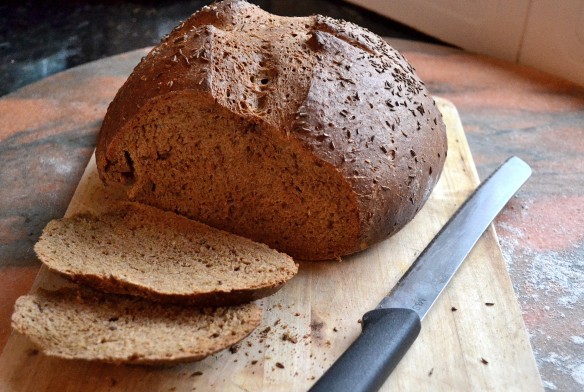 January’s obsession is bread. To be precise, January’s obsession is mastering sourdough, which I’ve always found intimidating. I AM NEARLY THERE, PEOPLE. When I am reliably turning out perfectly fluffy, chewy loaves, gorgeously slashed and floured, you can expect a (probably long-winded) blog post giving away all my secrets. Yesterday, however, I took a break from sourdough (er, I’m awaiting the delivery of a very high-gluten flour that will Make All The Difference), to make this yeasted orange cinnamon raisin bread. Continue reading
January’s obsession is bread. To be precise, January’s obsession is mastering sourdough, which I’ve always found intimidating. I AM NEARLY THERE, PEOPLE. When I am reliably turning out perfectly fluffy, chewy loaves, gorgeously slashed and floured, you can expect a (probably long-winded) blog post giving away all my secrets. Yesterday, however, I took a break from sourdough (er, I’m awaiting the delivery of a very high-gluten flour that will Make All The Difference), to make this yeasted orange cinnamon raisin bread. Continue reading
Tag Archives: Bread
Russian Black Bread
 Bread-baking is the antidote to everything that people find frustrating about pastry. Measurements are imprecise and dependent on variables such as ambient humidity and elevation. You can be messy and aggressive; bread dough responds to abuse rather like a particularly eager masochist. Bread dough likes being slapped and pounded, and “rustic” is an aspirational term, rather than a euphemism.
Bread-baking is the antidote to everything that people find frustrating about pastry. Measurements are imprecise and dependent on variables such as ambient humidity and elevation. You can be messy and aggressive; bread dough responds to abuse rather like a particularly eager masochist. Bread dough likes being slapped and pounded, and “rustic” is an aspirational term, rather than a euphemism.
I first started baking bread when I was about 11. A snarky, competitive, and somewhat fatalistic child, I decided to become a bread baker because it was the only type of kitchen craft that my mother did not execute impeccably; I didn’t want to cook things that she would always do better. Continue reading
Southern-Style Whey Crumpets
 For as long as I can remember, I have been fascinated by the food people eat in books. Reading descriptions of food in fiction, I remember thoughts along the lines of “I want to eat that,” and, as I grew older, “I want to replicate that.” The food in Laura Ingalls Wilder’s books was especially captivating. At my parents’ house in the Catskills, not content to eat potatoes baked in the oven, I would put mine in the fireplace. “It’s really good,” I would insist, as I chipped away the black carbonized exterior to get at what remained of my potato. When I was about 12, I was given the Little House Cookbook. I tried to make maple candy by pouring barely-caramelized maple syrup on snow (like chewy brown Rorschach blots; not an improvement), ice cream without a churn, in a bowl of salted ice (disastrous), and “Johnny Cakes.” (I don’t remember much, except that they were virtually inedible.) Someone later explained to me that the reason why Ingalls Wilder so vividly described food, and why it all sounded so delicious, was because she spent most of her childhood hungry.
For as long as I can remember, I have been fascinated by the food people eat in books. Reading descriptions of food in fiction, I remember thoughts along the lines of “I want to eat that,” and, as I grew older, “I want to replicate that.” The food in Laura Ingalls Wilder’s books was especially captivating. At my parents’ house in the Catskills, not content to eat potatoes baked in the oven, I would put mine in the fireplace. “It’s really good,” I would insist, as I chipped away the black carbonized exterior to get at what remained of my potato. When I was about 12, I was given the Little House Cookbook. I tried to make maple candy by pouring barely-caramelized maple syrup on snow (like chewy brown Rorschach blots; not an improvement), ice cream without a churn, in a bowl of salted ice (disastrous), and “Johnny Cakes.” (I don’t remember much, except that they were virtually inedible.) Someone later explained to me that the reason why Ingalls Wilder so vividly described food, and why it all sounded so delicious, was because she spent most of her childhood hungry.
As a youthful Anglophile, I found English food especially intriguing. (No, really.) Everything was exotic. The English drank sweet, milky tea in the afternoon. (In my household, tea was served black and unsweetened, with babka, after dinner.) They had toast with butter and jam for breakfast! They ate flamed Christmas pudding with suet (I’d been reading a lot of Dickens), and Yorkshire pudding, whatever the heck that was. But the ne plus ultra of English cookery was the mysterious crumpet. I WANTED CRUMPETS. I wanted to make crumpets. Somewhere I found a recipe for crumpets and I made them. Again, and again, and again. My poor parents. Continue reading
Fig, Leek, Blue Cheese, and Rosemary Flatbreads
Flatbreads are a lovely appetizer at a dinner party. The trick is planning ahead: if you make your dough and prep your toppings well ahead of time, assembly and baking takes only a few minutes. Easy peasy, right? This recipe is made with a yeast dough, with a slow, cold fermentation, somewhat similar to some pizza doughs. (The cold fermentation helps develop flavour.) Also like a pizza, the flatbreads are baked at a high temperature, which yields a crisp crust and nice caramelisation on top. Figs, blue cheese and rosemary are a natural combination for the topping; the leeks add sweetness, moisture, and depth. But really, you can top your flatbreads with anything you like. Continue reading

